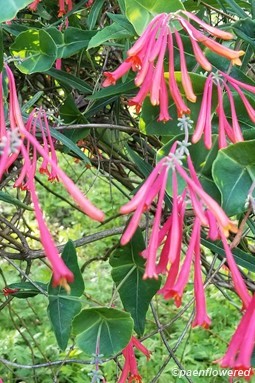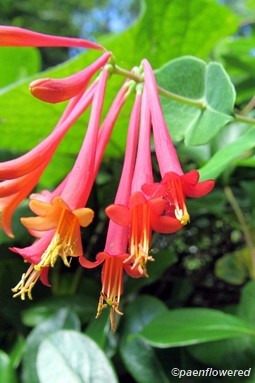Lonicera sempervirens
Climbing vine that likes to entwine itself around tree trunks and other plants
Lonicera sempervirens trumpet honeysuckle
This native perennial member of the honeysuckle family is a smooth-stemmed climbing vine that can grow up to 16 feet long. It is often found entwined around bushes and tree branches. The scarlet red flowers are in the form of slender trumpets that flare into five lobes at the end. The inside of the flowers are orange. These attractive flowers grow in whorled clusters and are 1-2 inches long. Yellow styles and anthers protrude from the end of the flowers.
The roundish opposite upper leaves often embrace the stem. They are deep green with a whitish bloom on the underside. It is found in woods and thickets throughout eastern and central United States. It blooms from April to September. The fruit is a scarlet berry. The berries may cause nausea and vomiting if consumed by humans.
The trumpet honeysuckle is a popular ornamental plant and will frequently attract hummingbirds. Generally, it will need a trellis for climbing. A number of cultivars have been produced for garden use. The species name translates into “always green” and refers to the evergreen nature of the leaves, especially in southern locations. In the northern part of its range it may be deciduous. It is also called the coral or scarlet honeysuckle. There are about five other similar species that have more widely flaring lobes.
Habitat & Range
Occasional in fencerows, thickets and roadsides.
Mostly grows in the southeast, but is found elsewhere in the state.
Range: Found in eastern and central US.
| EMP: | FACU |
|---|---|
| NCNE: | FACU |
Phenology
Flowers late May through June or later.
Fruits in July.
Plant Codes
S-rank: No rank
G-rank: G5 (Secure)
.jpg?v=638486359200000000)




.jpg?v=638120063270000000)







Comments
Have you spotted this plant in your area? We'd love to hear about your experience! Share your comments or questions about the plant below. Comments are moderated before posting.